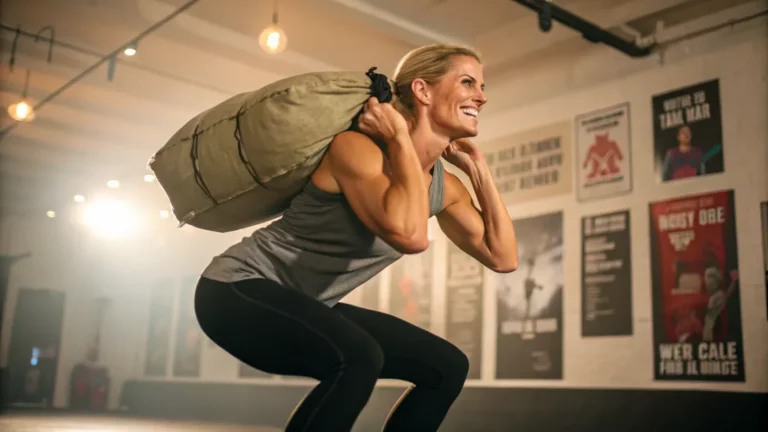Are you ready to unlock the power of a truly effective full-body workout that will test your strength, endurance and explosive power?
Then you need to learn the sandbag burpee.
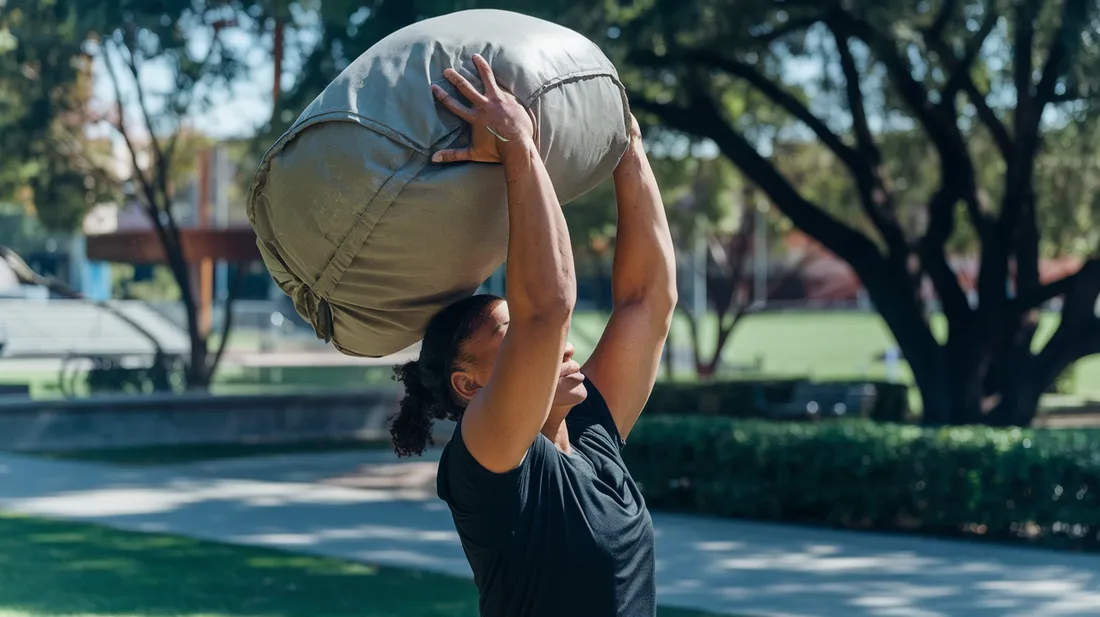
This dynamic and challenging exercise combines the best of strength training and cardio, in one simple, yet very potent movement.
The sandbag burpee is an exercise that will test your fitness levels to their maximum, and show you how to achieve results.
This guide will help you to understand the unique benefits of the sandbag burpee exercise.
You will learn how to perform this dynamic full body workout, and you will also learn about the different variations, to keep your training fresh and interesting.
You will be given all the tools you need to perform this exercise correctly, and safely, and start working towards your fitness goals today.
The Benefits of Sandbag Burpees
The sandbag burpee exercise is more than just a challenging movement; it’s a potent tool for transforming your fitness.
Here’s a breakdown of the specific benefits you can expect to achieve from this dynamic exercise:

Full-Body Strength and Conditioning
- All In One Workout: The sandbag burpee is a very effective way of doing a full body workout, by combining strength, and cardio into one movement. This is much more efficient than using a range of different exercises, and it also means that you can get a great workout in, even when you do not have a lot of time.
- Major Muscle Groups: This exercise engages all your major muscle groups, including your legs, core, back, arms and shoulders, building a well-rounded and balanced level of fitness. This will help to improve your overall strength, and will help you in many different activities.
Explosive Power
- Improve Power Output: The dynamic and explosive nature of the sandbag burpee is a great way to build power in your legs and your core. This is due to the fact that this type of training uses both speed, and strength, to perform the exercise.
- Carry Over: This will translate to a greater power output in other exercises, as well as in your daily tasks. The power that you build doing this exercise, will carry over to a wide range of different physical activities.
Core Strength and Stability
- Core Engagement: Sandbag burpees require a lot of core engagement to perform correctly, and will build both core strength and stability, which is vital for everyday tasks and sports performance.
- Stabilizing Muscles: The unstable load of the sandbag, will force your core to work harder to stabilize your body during the movement, leading to improved core strength and stability, which will help to protect your back, and will improve your overall balance.
Cardiovascular Endurance
- Build Stamina: Sandbag burpees will challenge your cardiovascular system, and push you to your limits. They are a great way of building stamina, endurance and your ability to resist fatigue.
- Full Body Cardio: The combination of a full body movement pattern, and the intense nature of the exercise makes it a great way to build cardiovascular endurance.
- Fat Burning Potential: The sandbag burpee is a very demanding exercise, that burns a lot of calories. This means that it is a great exercise to burn fat, and lose weight.
How to Perform the Sandbag Burpee Correctly
The sandbag burpee is a challenging exercise, and proper form is vital to get the full benefits, while also ensuring that you do not injure yourself.
Here’s how to perform the sandbag burpee correctly, with step-by-step instructions:
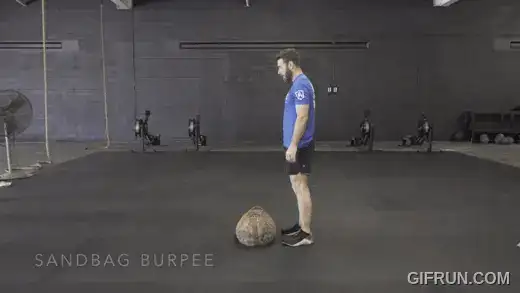
Step-by-Step Instructions
- Starting Position: Stand with your feet shoulder-width apart, with the sandbag in front of you.
- Squat Down: Bend at the knees, and push your hips back into a squat position. You should keep your core engaged, and your back straight.
- Place the Bag: As you squat down, pick up the sandbag using both hands, and hug it to your chest.
- Jump Back: Place the sandbag on the floor in front of you, and jump your feet back into a plank position. Ensure that your core is engaged, and that you are not letting your hips drop to the floor.
- Perform a Push Up: Perform a push-up, by lowering your chest towards the floor, and pushing back up with your arms.
- This step can be skipped if you are a beginner.
- Jump Back to Squat: Jump your feet forward to return to a squatting position, making sure that you are keeping your back straight.
- Lift and Extend: As you stand up, pick up the sandbag and lift it overhead, extending your arms fully above your head. Use an explosive movement to lift the weight, and to stand up, using your core, and legs.
- Repeat: Repeat the exercise for the desired number of reps.
Proper Form
- Engage Your Core: Keep your core muscles engaged throughout the exercise, as this will help to stabilize your body and to protect your lower back.
- Straight Back: Keep your back straight throughout the movement, and avoid rounding your back at any point in the exercise.
- Controlled Movements: Perform the movement slowly and in a controlled manner. The focus should be on the quality of movement, rather than speed.
- Use your Legs and Core: You must use the power from your legs and core, to drive the movement. Avoid using your arms to lift the weight.
- Full Extension: Fully extend your arms above your head at the top of the movement.
Common Mistakes to Avoid
- Rounding your back: Avoid rounding your back at any point during the exercise, as this can lead to injuries in your lower back. You should always maintain a straight back during the burpee.
- Using Momentum: Do not use momentum to perform the movements. Try to control your body throughout the exercise, and perform it in a slow and deliberate manner, so that you can control each movement.
- Not Engaging Core: Make sure to keep your core engaged throughout the movement, so that your back is protected, and you are building strength in the muscles that are most important during the exercise.
- Rushing the Exercise: Always focus on doing the exercise correctly, rather than rushing to complete the sets. You must do the movements slowly, and always focus on your form, and technique.
- Dropping the Weight: Do not drop the sandbag on the ground. You should always place the sandbag carefully on the floor during the exercise, to prevent injury, and to ensure that you are maintaining proper form.
- Overtraining: If you are new to training, then you should always start slowly, and with the basic movements, and focus on learning the proper form. If you do too much too soon, then it will increase your risk of injury.
Sandbag Burpee Variations
While the standard sandbag burpee exercise is a fantastic full-body workout, it is also important to understand that there are many variations, that can be used to make the exercise more accessible for beginners, and more challenging for advanced users.
Here’s a breakdown of different variations and how to progress:
Table 1 – Sandbag Burpee Variations
This table will summarize the different sandbag burpee variations, and includes the benefits and the recommended sets, and repetitions.
| Variation | Description | Benefits | Sets | Reps |
| Beginner Sandbag Burpee | Modified burpee without a push-up or overhead lift. Focus on mastering the basic movements and learning the proper form. | Provides a good starting point for those new to the exercise. | 2-3 | 5-8 |
| Sandbag Burpee with Push Up | Perform a standard sandbag burpee and add a push up when you are in the plank position. | Adds more intensity, and will improve upper body strength. | 2-3 | 5-8 |
| Sandbag Burpee with a Squat | Perform a standard burpee, and combine this with a squat when you are standing up. | This is a great way to challenge the lower body muscles, and build leg and core strength. | 2-3 | 5-8 |
| Advanced Sandbag Burpee Variations (Burpee Throw) | Perform a full sandbag burpee and add an overhead throw at the top of the movement. | This is a great way of improving power output, muscle coordination, and explosiveness. | 2-3 | 5-8 |
| Advanced Sandbag Burpee Variations (Burpee with a Power Clean) | Perform a full sandbag burpee, and add a power clean at the top of the movement. | Improves full body power and coordination. | 2-3 | 5-8 |
Beginner Sandbag Burpee
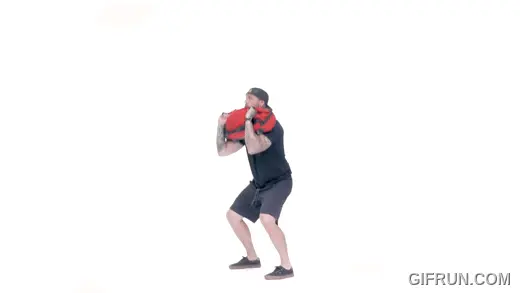
- Instructions: Perform a modified burpee without the push-up or overhead lift, and focus on mastering the basic movements and learning the proper form.
- Stand with your feet shoulder width apart, with the sandbag in front of you.
- Squat down, while keeping your core engaged, and your back straight.
- Pick up the sandbag, and put it on the floor in front of you, and step back into a plank position, making sure to keep your core engaged.
- Step your feet back to the squat, and stand up again, without lifting the sandbag overhead.
- Repeat the movements for the given time or repetitions.
- Benefits: This variation helps you to learn the proper form, and it is a good starting point, for those new to training.
- Safety Tips: Focus on keeping your back straight, and core engaged. Do the movements slowly and in a controlled manner, and focus on learning the technique correctly.
- Sets and Reps: 2-3 sets of 5-8 reps.
Sandbag Burpee with a Push-Up
- Instructions: Perform the standard sandbag burpee, and add a push-up when you are in the plank position, to add an extra level of difficulty.
- Stand with your feet shoulder width apart, with the sandbag in front of you.
- Squat down, while keeping your core engaged, and your back straight, and pick up the sandbag.
- Put the sandbag on the floor in front of you, and jump your feet back into a plank position, making sure to keep your core engaged.
- Perform a push up. This can be done using a full push up, or a modified push up.
- Jump back to a squat position, and stand up to the starting position.
- Repeat the movements for the given time, or repetitions.
- Benefits: Increases the intensity of the workout, and strengthens your chest, shoulders and arms.
- Safety Tips: Ensure you have the strength to do the push up correctly, and keep your core engaged during the movement. If you are unable to do a full push up, then you can do a push up on your knees, and you can also stop using the push up entirely if it is not working for you.
- Sets and Reps: 2-3 sets of 5-8 reps.
Sandbag Burpee with a Squat
- Instructions: Perform the standard burpee, and combine this with a sandbag squat when you are standing up.
- Start in a standing position with the sandbag in front of you.
- Squat down and place the bag on the floor, and perform the jump back to a plank position.
3. Jump back to the squat position, and as you stand up, pick up the bag and perform a sandbag squat, while holding the sandbag at your chest. - Place the bag on the floor and repeat the steps.
- Benefits: This exercise is great for improving lower body strength, and will engage your legs, core and back muscles.
- This variation focuses on leg strength.
- Safety Tips: Focus on the technique for the squat, and keep your back straight, and engage your core muscles throughout the exercise.
- Sets and Reps: 2-3 sets of 5-8 reps.
Advanced Sandbag Burpee Variations
- The Burpee Throw:
- Instructions: Perform the full sandbag burpee, and add a sandbag throw at the top of the movement, where you explosively throw the sandbag up in the air.
- Benefits: This will improve your explosive power and coordination.
- The Burpee With a Power Clean:
- Instructions: Perform the standard burpee, and then add a power clean at the top of the movement.
- Benefits: This will improve full body power, explosiveness and strength.
Progression
- Master the Basics: Always start with the basic sandbag burpee and then gradually add variations as you get more comfortable with the exercise.
- Gradual Progression: When you feel ready to progress, only add one variation at a time. Make sure that you master each variation, before moving onto a new one.
- Listen to Your Body: Ensure that you listen to your body and never force yourself into an exercise that feels too difficult or uncomfortable.
Integrating Sandbag Burpees into Your Workout Routine
The sandbag burpee is a very versatile exercise, and can be integrated into a range of different workout routines, to help you reach your fitness goals.
Here are some ideas on how to incorporate this into your training, along with advice on frequency, rest and recovery:
Table 2: Sample Sandbag Burpee Workout Ideas
This table will provide some ideas on how to combine the exercise in a workout, and how to structure the different types of routines.
| Workout Focus | Description | Key Points |
| Cardio | Perform sandbag burpees for short periods with short rest periods, to improve cardiovascular fitness and endurance. | Focus on high intensity and move quickly from one movement to the next. |
| Strength | Focus on proper form and use heavier weight with lower repetitions to improve strength, and build power. | Focus on controlled movements and fully engaging the muscles in each part of the exercise. |
| Endurance | Perform sandbag burpees for longer periods with a lighter weight, to improve muscular endurance, and to improve fatigue resistance. | Focus on pacing and maintaining your posture. |
Workout Routine Ideas
- For Cardio:
- High-Intensity Intervals: Perform sandbag burpees for a short period of time (e.g., 30 seconds), followed by a rest period (e.g., 15 seconds), then repeat this process for multiple sets. This will challenge your cardiovascular system, and improve your overall fitness.
- You can also do a set number of burpees as fast as you can, and then rest. Repeat this for several sets.
- For Strength:
- Lower Repetitions, Higher Weight: Use a heavier sandbag and perform the burpees with a focus on power and strength. Limit the repetitions, to ensure that you are working on your maximum strength. This is also a great exercise to combine with other strength exercises.
- For Endurance:
- Higher Repetitions, Lower Weight: Use a lighter sandbag, and perform the burpees for a longer period, and focus on building your endurance and fatigue resistance.
Workout Frequency
- Start Gradually: If you are new to sandbag training, you should start slowly by doing 1-2 sandbag burpee sessions per week, with other training days scheduled in between.
- Listen to your Body: You should always pay attention to your body, and avoid overtraining. If you are feeling tired or sore, then it is important to take rest days, or reduce the intensity of your workouts.
- Increase Gradually: As your fitness improves, gradually increase the number of sessions per week, whilst ensuring you have adequate rest and recovery time.
Rest and Recovery
- Rest Days: Plan for adequate rest days in between workouts, to allow your body to recover. Rest is very important to allow your muscles to repair, and grow.
- Listen to your Body: Pay attention to your body, and avoid over training. If you are feeling any pain, or discomfort, then you must take a rest.
- Nutrition: Maintain a well-balanced diet that provides the nutrition that your body needs. You should also ensure that you are well hydrated.
- Sleep: You should be getting at least 8 hours of good quality sleep every night.
Choosing the Right Sandbag for Burpees
Selecting the right sandbag is essential for performing the sandbag burpee exercise effectively and safely.
Here’s a guide to help you choose a sandbag that best suits your needs, your training, and your budget:
Weight Recommendations
- Beginner: If you are new to sandbag training, start with a lighter sandbag (10-20 lbs), and focus on mastering proper form and technique. You should only move on to a heavier weight, when you have become more comfortable with the exercises.
- Intermediate: If you are intermediate, you should use a medium weight sandbag (20-40 lbs), to increase the intensity of your workout, and to challenge your muscles more.
- Advanced: If you are advanced and are looking for the best way to build strength and explosiveness, then you can use heavier weights (40lbs +).
- Adjustable Weights: An adjustable sandbag is very beneficial, as it will allow you to vary the weight, depending on your needs, and what you are trying to achieve. This also means that you will not have to purchase multiple sandbags, and that you can gradually increase the weight, as you improve.
Size and Material
- Compact Size: Choose a sandbag that is not too bulky and is comfortable to handle. A medium-sized, cylindrical sandbag is often the most versatile, and effective option, as you can hold them easily when you are performing the burpee.
- Durable Material: Opt for a high-quality, durable material that can withstand repeated impact, such as heavy-duty nylon, or reinforced canvas. These materials are designed to be durable, and will withstand repeated use. They also protect the inner liner from damage.
- You may also want a material that can be cleaned easily.
Handle Design
- Multiple Handles: Choose a sandbag that has multiple, reinforced handles, as this will allow for versatile use, and will also allow you to grip the sandbag in different ways.
- Comfortable Grip: The handles should be comfortable to hold, and provide a good grip. They should be made from strong webbing, or rubber and should be slip resistant. You should look at the stitching to ensure that the handles are firmly attached.
- Strategically Placed: Look for handles that are placed on the sides and ends, as this will allow you to perform a wider range of movements, and to hold the sandbag in the correct way.
DIY Options
- Duffel Bag: You can create your own sandbag by using an old duffel bag, and filling it up with sand. This is a low cost option, and is perfect if you are on a tight budget, or if you are looking to start immediately, without spending any money on equipment.
- Heavy Duty Bag: You can purchase a heavy-duty bag with a zipper, and use this as a low cost way of creating your own sandbag. You simply fill it up with sand, and close it with the zipper.
- Inner Liners: Ensure that you are using inner liners for your sandbag, such as plastic bags, or waterproof bags, to prevent any leakage.
Key Considerations
- Your Needs: When selecting a sandbag, always consider your individual needs, and your fitness goals.
- Durability: Make sure that the sandbag you choose is durable, and that it will last for a long period of time.
- Comfort: Make sure that the bag is comfortable to hold, and easy to maneuver during the exercises.
FAQ (Frequently Asked Questions)
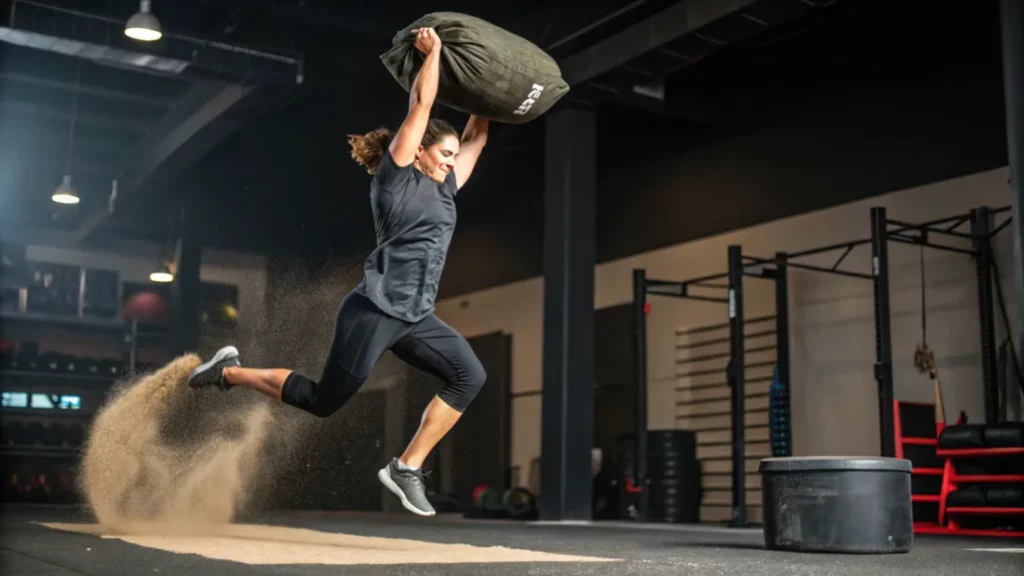
Here are some common questions and clear answers about the sandbag burpee exercise:
- Is the sandbag burpee suitable for beginners?
- Yes, with modifications. Beginners should start by mastering the basic movements, and they should do the modified version of the sandbag burpee. It is best to start by focusing on form, and technique.
- Do not try to perform the exercise at a high intensity, or with a heavy weight. Always seek advice from a fitness professional, before starting a new training routine.
- Is the sandbag burpee better than the traditional burpee?
- Both exercises are highly effective, but sandbag burpees provide an additional challenge by adding an unstable load, and will help to build greater functional strength. They also build upper body and core strength, as you have to lift and control the weight of the sandbag.
- The sandbag burpee, is also very versatile, as you can do a wide range of different variations.
- The type of burpee that you choose will depend on your preferences, and fitness goals.
- How to progress with sandbag burpees?
- Master the Basics: Always focus on mastering the correct form, before you move on to more advanced variations, and to higher intensity training.
- Increase Reps and Sets: Gradually increase the number of repetitions and sets, to challenge your body further.
- Increase Weight: Once you are comfortable with your current weight, you can slowly increase it to provide a greater challenge, and to push your body further.
- Try More Difficult Variations: As you get more comfortable, you can move to more complex variations.
- How can I make the sandbag burpee more challenging?
- Add a Push Up: Adding a push up will help to increase the intensity and to strengthen the upper body muscles.
- Add a Squat: Adding a squat, will help to improve lower body strength, and to improve stability and balance.
- Add a Throw: By adding an overhead throw, this will add an extra challenge and it will improve explosive power, and muscle coordination.
- Try a Power Clean: You can also add a power clean to the movement, to challenge your full body strength.
- How to do a sandbag burpee safely?
- Proper Form: Always focus on using the correct technique, and good form to avoid injury.
- Controlled Movements: Use controlled movements, and do not rush through the exercises.
- Listen to Your Body: Always listen to your body and stop immediately if you experience any pain or discomfort.
- Appropriate Weight: Make sure to use an appropriate weight for your fitness level.
- Warm up and Cool down: Always make sure that you perform a warm up before each workout, and perform a cool down when you are finished.
Conclusion – Maximize Your Fitness Potential with Sandbag Burpees
You now have a comprehensive guide to mastering the sandbag burpee exercise, and you can use this information to unleash your full fitness potential.
This is more than just an exercise; it’s a tool to transform your strength, power, and endurance, and it is a great way to challenge your body to the limits.
It will also allow you to work on your functional strength and fitness, all with just one exercise.
Let’s quickly recap the benefits of incorporating sandbag burpees into your workouts:
- Full Body Conditioning: You will build strength, and power in all your major muscle groups, as it combines cardio and strength into one movement.
- Explosive Power: You will improve your power output for other exercises and for your daily activities.
- Core Strength: The exercise will challenge your core, and improve core strength, stability and balance.
- Cardiovascular Endurance: You will improve your overall endurance, and cardiovascular fitness.
It’s time to take action, and take control of your fitness journey.
Start by mastering the technique, and then move on to the variations, to push your body to the limits.
The sandbag burpee is a powerful, versatile and dynamic exercise, that will provide you with a comprehensive full body workout.
Are you ready to unlock your full potential with the power of the sandbag burpee?
References
- Mikel Izquierdo The , Keijo Häkkinen, Javier Ibáñez, William J Kraemer, Esteban M Gorostiaga. Effects of combined resistance and cardiovascular training on strength, power, muscle cross-sectional area, and endurance markers in middle-aged men. https://pubmed.ncbi.nlm.nih.gov/15616847/
- Stephen F. Austin State University. Recovery Methodologies and High Intensity Interval Training. https://facultyshowcase.sfasu.edu/ws/portalfiles/portal/39864162/Recovery Methodologies and High Intensity Interval Training.pdf


